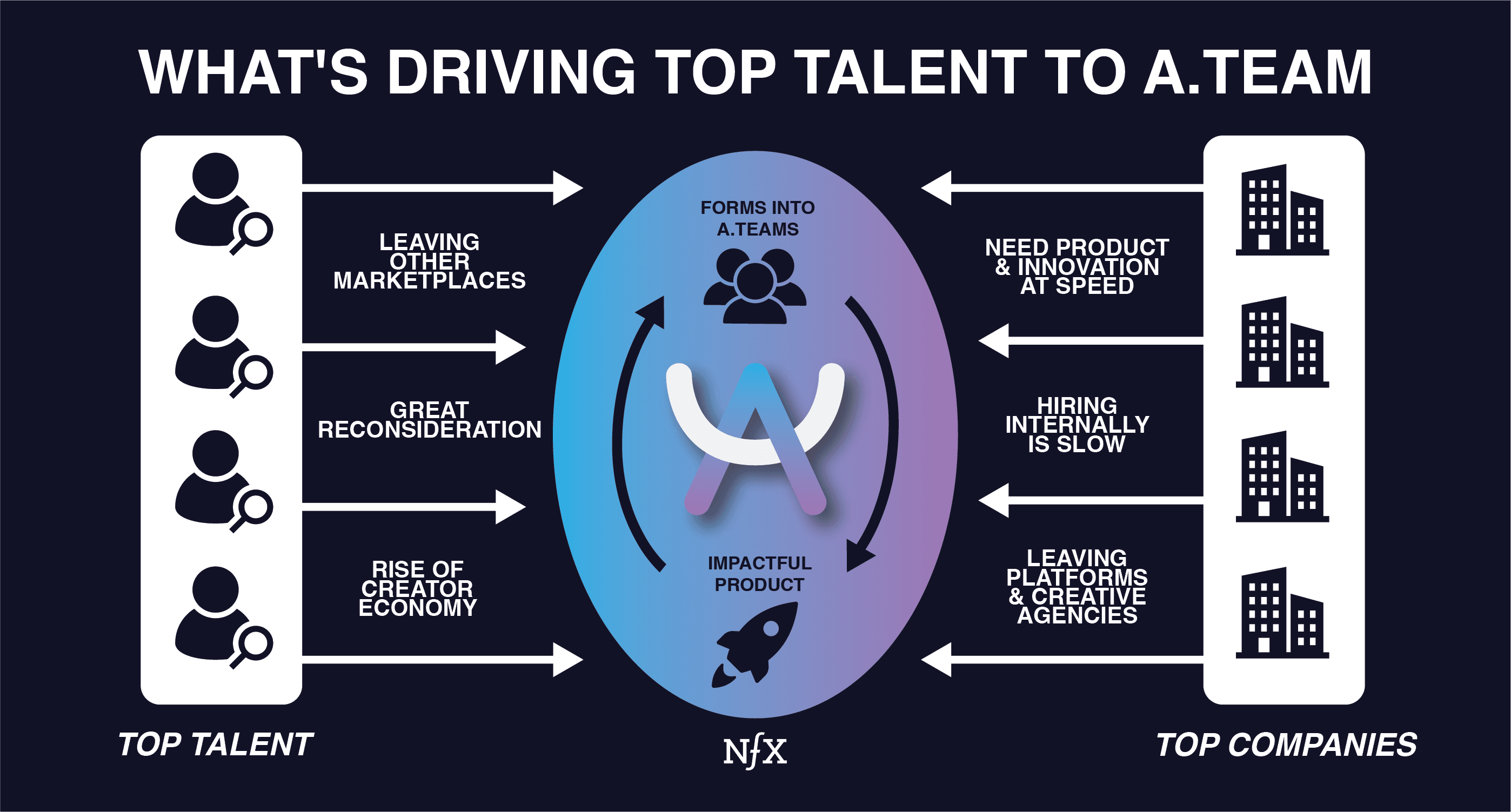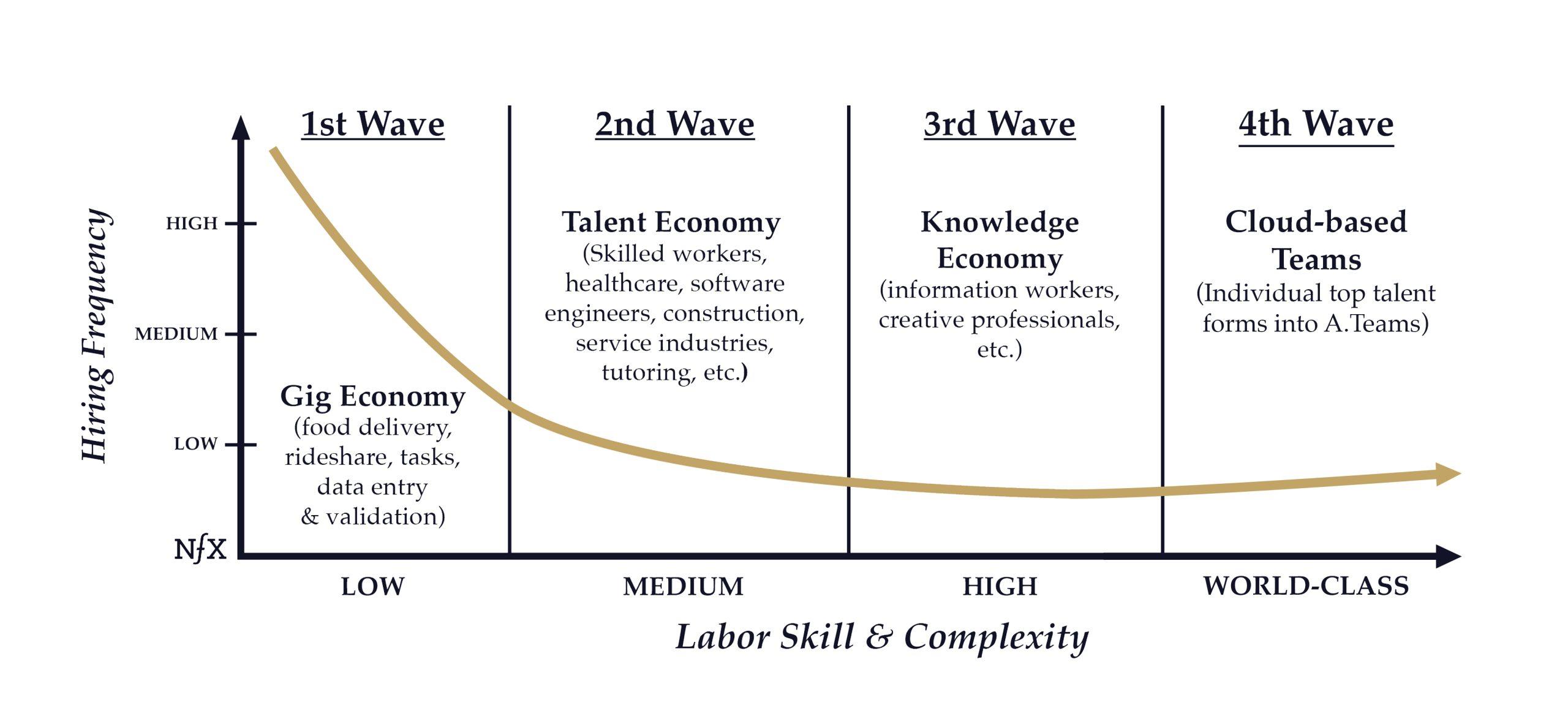

In a sea filled with marketplace whales, finding blue ocean opportunities can feel impossible.
You want to revolutionize transit? Good luck with Uber and Lyft around. Want to get into food delivery? There’s barely standing room. Want to streamline the gig economy? People have done that already. Just look at Fiverr and Upwork.
But often, there are unseen problems at the core of major success stories. Great founders aren’t blinded by incumbents – they are gifted with insight to spot inefficiencies, evolutions, and build for the next generation. A network that might have grown quickly might now be asymptoting. The demand side might not be getting what they really want. The supply side might be wilting as prices are constantly driven down. Or culture shifts may have enabled entirely new behaviors.
We’ve seen that a new marketplace can break out by uniquely innovating on product, demand, and supply.
The perfect example of a breakout marketplace is A.Team. Last year, NFX led the $5M Seed round for A.Team and they just announced their $55M Series A. A.Team’s founder Raphael Ouzan saw what others did not: a generation of amazing workers (and companies) who were not served by the existing gig-based marketplaces – even though the market thought they were. Not all supply and not all demand is created equal.
So A.Team repositioned the whole idea and status of independent work, and created an entirely modern labor marketplace. Let’s take a look at what other marketplace Founders can learn from A.Team’s insights – and how you can build new marketplaces where others only see crowds.


Unlocking Latent Supply: A.Team’s Secret Weapon
Two years ago, my NFX partner Pete Flint published this essay “The New Generation of Labor Marketplaces and the Future of Work.” In it, he explains our belief that unlocking latent supply is key to marketplace success. One interesting way to do that in labor is via technology and automation. The most interesting labor marketplaces tend to use technology to increase the value that labor provides.
Another way to unlock latent supply is to change how you define supply. Fiverr did this well for the freelancer economy. As I’ve discussed with Fiverr CEO Micha Kaufman, Fiverr had no problems attracting supply, but the trick was packaging that supply to satisfy the more constrained part of this marketplace: demand. Fiverr developed a SKU system to map the skills of the labor pool in granular detail (it also allowed Fiverr to understand what particular skills might be missing from the platform at large). It changed the amorphous ecosystem of freelance workers into a product catalog. You weren’t buying the person’s work, you were buying the product they could create. That was Fiverr’s initial reframing of the freelance labor supply and it worked well for them and a section of the labor market.
A.Team has a different solution. It is a members-only network that brings builders together – the world’s top engineers, designers, marketers, product managers, and more. But A.Team doesn’t just bring them into the platform as solo contributors – it matches them into teams, and then connects them with genuinely interesting, innovative product-building opportunities at prestigious companies.
A.Team saw a huge amount of latent supply in the form of talented programmers, developers and product people who wanted freedom from the traditional “one job, one company” career mentality and were also redesigning their work lives as part of the Great Reconsideration. But this supply was locked as they didn’t want to work alone on non-innovative tasks – which is what you generally get when you use most gig marketplaces. A.Team realized that to unlock this supply – and inherently free the value of all these top-shelf individual workers – they needed a way to work together, a feature traditional independent labor marketplaces didn’t support (and in essence, discouraged). The technology that unlocked that latent supply: cloud-based teams, which allow companies to tap into on-demand teams to solve any problem (think AWS but for top tech talent).
The approach worked right away. For example, during the first waves of the COVID-19 pandemic, a company called Apprentice was building software to help vaccine manufacturers manage delivery pipelines. But that job became too daunting for the small in-house team as a large deadline loomed: The team had 45 days to overhaul their software to aid in global vaccine delivery.
Apprentice used A.Team to hire a cadre of 20 engineers who weren’t just there to execute on basic tasks. They were there to literally build something new. In 45 days, the new software was up and running.
That story contains a few widely applicable concepts worth detailing. Let’s dive in.
Spotting the Unseen Problem
The first thing A.Team did was spot an unseen problem on the supply side. There are plenty of marketplaces for independent workers, but none of them were built for a certain type of knowledge worker: someone who wanted to build big things and tackle meaningful problems.
At the core of the incumbent marketplaces was some broken logic: assumptions that independent workers could be retrofitted into the model forged by the gig economy (quick hit, low-lift, solo jobs). If you take a close look at the opportunities posted on platforms like Upwork and Fiverr, you’ll find that they’re built around “small, one-off jobs.” These are tasks that any designer or programmer worth their salt can do, but these are not the tasks that get them out of bed in the morning. They’re not creatively fulfilling, and it also takes a LOT of these jobs to add up to a real paycheck. It’s a treadmill.
This was a powerful realization because those low-lift jobs were actually crippling the networks within these one-off project marketplaces. These companies will eventually reach a point where each new person added to the network is of marginal value to the end user – an asymptotic marketplace. The classic example of this is Uber or Lyft. While adding more drivers to the network initially decreases taxi wait times, once you reach a certain threshold, that decrease isn’t meaningful (i.e. it’s not that much better to wait two minutes as opposed to four minutes for a cab).
In the case of most existing labor marketplaces, designers, engineers and programmers could only compete over the same low-lift tasks. Each time a new talented person joined the network, it did little to enhance the experience of those already there. To add to that, these low-level tasks left them very little room to differentiate themselves, other than charging less than competitors, which is the opposite direction from where they need to go.
Importantly, A.Team’s leadership realized that this was a reality created by other platforms’ rigidity. There was no way to work with new people in the network, and no way to take on bigger or more exciting projects together. People who wanted to work differently were trapped by the existing ecosystem, not served by it. Even if the gig platforms let you team up with others and offered more advanced services, you were still limited to the team members you already knew. There was no flexibility to create teams on the fly based on what customers need.


Meanwhile, A.Team’s leadership was also noticing a culture shift. The problems inherent in the old talent marketplaces (uninteresting work, low wages, no career growth, un-networked) were still there. But there was a confluence of the Covid-19 pandemic, the Creator Economy, and the rise of web3, that unlocked an unprecedented increase in “free agent” individual top talent.
This isn’t to say that A.Team couldn’t have taken off five years ago. It probably would have. Rather, this cultural shift was just another tailwind working in their favor. If you’ve got a trend working for you, all the better.
Here was A.Team’s blue ocean: sure, you could find work on an existing platform, but not the kind of work people wanted to do in the way they wanted to do it. A.team had to give these top builders the freedom and flexibility of a gig platform, together with the challenging, innovative teamwork you generally get only by joining a company.
What About the Demand Side?
The power of unlocking latent supply is that it can also have an effect on the demand side of the marketplace. In this case, the demand side is represented by world-class companies looking to build impactful products, tools and projects. To succeed, these companies must bring in the most innovative product building skills to enhance their internal capabilities. But other than traditional hiring, there was no way to instantly bring in a full team capable of that high-level work. By allowing people to work in teams, A. Team actually solved several problems at once for these companies using the platform.
One of them was purely functional. Onboarding one person at a time is annoying, and too slow to match the pace innovation requires. A.Team’s platform fixes that immediately. But that on its own probably isn’t enough to build a whole business around.
The bigger inefficiency was ideological. What do you think of when you think of the word outsourcing? It’s a cost-cutting measure. A.Team realized that most platforms were built around the idea that contract workers were the CFO’s best friend. But that idea is actually inconsistent with what we also know about great companies. They are always seeking high quality talent. So much so, that the best CEOs and hiring managers will spend extra for high quality people. So A.Team solved the talent problem. They surfaced those super high quality people to the right audience. They sold to CEOs and product people, rather than CFOs, giving companies access to talent that was not available in any other way.
They recognized that the demand side had become locked into one mental model: Outsourcing is for low lift, low cost projects.
Then, they surfaced a reframed mindset within that same demand: We will pay for great talent, regardless of where it comes from.
That subtle shift repositions the entire idea of contract work. It’s a way to solve big problems, not small ones. It’s a way to accelerate the pace of your innovation, not to reduce your costs.
Finding Your Key Lever
It’s one thing to spot a problem. It’s another to solve it. You need to find the one core concept that will broadly address the problems you’ve identified.
For A.Team, the answer was allowing people to work in teams.
At a first glance, this answer seems risky. Isn’t the whole point of leaving a company to go solo?
That’s the simple explanation, but it misses the nuance of why people leave companies. They realized that people actually left companies because they were bored, or wanted more freedom. It’s especially true in the web3 world, where people self-organize around interesting projects. They wanted a more flexible and dynamic environment – but that actually doesn’t mean working alone. And they definitely didn’t want the by product of working alone – having to work on boring tasks.
The next-generation of independent workers actually don’t want to go it alone. So it was worth challenging the old assumptions.


A.Team doubled down on this idea. And in practice it proved to be an even stronger thesis. Allowing people to build teams solved the asymptote problem. If you build a platform that allows people to team up – that actually teams them up perfectly automatically – they’re no longer in competition driving each other’s value down to zero. They’re able to form dense subnetworks. A programmer can team up with a designer, or a product professional to tackle a bigger, more complex, and perhaps more rewarding problem – not just compete over a task.
Raphael described what the removal of that asymptote meant for his platform’s growth (and the needs of the workers who joined) extremely well:
“When we started putting together this team platform, it immediately became clear this was the way for people to finally break free of rigid structures. They quickly started bringing in their favorite peers, and colleagues, or people they would really enjoy working with, who bring different skill sets but overlap in their values and the way they like to work.”
This was especially smart because of what team-based marketplaces unlocked on the demand side. Once you allowed people to work in teams, the array of services they could offer became increasingly more complex. Companies began to see this new pool of workers differently: as teams of problem-solvers.
The result was the creation of a self-perpetuating cycle. Top professionals came to A.Team because they were not served by other marketplaces. They wanted to differentiate themselves, and work in teams of like minded people on meaningful projects. They were aided by cultural tailwinds that helped clarify that desire in their own minds.
This, in turn, created something new and interesting for the demand side, who realized that outsourcing wasn’t just about cutting costs, but about adding additional value. So companies brought interesting projects to A.Team, which attracted more top talent, and so on.


Building a New Marketplace in a Crowded Space: A 3-Part Framework
If you put the right thought processes to work, you can spot new opportunities in seemingly saturated spaces.
Step 1: Look for holes in the existing marketplaces on the supply side.
That begins with a simple question: who is, and isn’t served by the existing marketplace? But challenge yourself to go deeper.
Are they served emotionally?
Are they served financially?
Are they working in a way that feels natural to their industry?
Are the opportunities available to them things that people would be inherently excited about?
In short, is the existing marketplace too rigid to accommodate the multifaceted needs of the supply?
Especially look for pockets of supply that should have been served by the marketplace but choose not to participate and find out why that’s happening. What could get them to participate? What needs to be changed for this latent supply to be unlocked?
In A.team’s case, these were the top product builders who decided to not take part in the existing marketplaces which offered lowly tasks and working alone. By offering them to build innovative products in teams of like-minded people, this unique latent supply was released.
Step 2: Look for holes on the demand side
It’s tempting to identify a whole new source of demand. Consider challenging yourself to sell a new product to the same demand. That means getting inside the head of your prospect.
How do they currently view the existing supply?
Is that supply seen as high value or low value to them?
Can I change that?
Who else within the C-suite might have a different mindset when it comes to my supply, and how can I speak to that decision maker?
Specifically ask what would the demand like to get from the marketplace that’s not available now, and what’s the potential if they can get that new product.
In A.Team’s case, these were companies looking to accelerate their innovation, and build better products faster. They couldn’t achieve this using existing marketplaces.
Step 3: Find your actionable, unifying concept
Sometimes a simple solution will solve for inefficiencies on both supply and demand side. A. Team decided on teams as their unifying concept because teams were the “core unit of work” amongst top talent and top companies.
On the supply side working in teams increased each person’s individual value, and allowed them to work the way they wanted to. On the demand side, teams made it possible for companies to solve bigger problems and accelerate innovation – making A.Team even more valuable in their eyes.
How do you know when you’ve hit on the right core concept? It may seem trite, but the energy will speak for itself. You shouldn’t need to do marketing acrobatics to know its working. At A.Team, the energy was palpable right away, as Raphael has noted:
“It was very clear, admittedly, as we started enabling cloud-based teams to form, that there was something that was really hitting a nerve. You could feel this incredible feeling, even in the Zoom rooms, among people coming together to build something and companies that were forming those teams. Suddenly, they had the superpowers to build like they could never have before. We wanted to go for no validation other than the validation of something that really clicks.”
A strong core concept is infectious and energizing. It doesn’t need to be propped up.
We saw A.Team put the above framework into action, and we’re excited to see what other marketplace Founders will do.
Entering The 4th Wave in the Labor Markets: The Teams Economy


When we published our New Generation of Labor Marketplaces essay in 2020, it was clear that The Knowledge Economy was driving forward a new wave of talent. The most important trend we see in labor marketplaces is towards onboarding increasingly skilled workers and offering greater complexity of service.
Now we are setting a trend for organizing and bonding that talent. We are on the cusp of entering a 4th wave: the Teams Economy: individual talent, perhaps working remotely, teaming up with other high quality talent to create and build project after project, protocol after protocol, with something challenging and fun to create around every corner.
We’re seeing how these new kinds of teams are defining work in the Web3 space. My partner Morgan Beller recently talked about how: “Having one job in Web3 is increasingly viewed as passé. Someone had a tweet that said that the “3” in Web3 stood for three jobs.”
She simultaneously surfaced the trend and the problem. A new wave of talented people wants to work on complex, interesting projects. But the companies who need them, want them to work together and in a focused way. The Teams economy – and A.Team at the forefront, is a powerful emerging solution.
We know that there are an infinite number of potential marketplaces ready to be unlocked. But we believe that the next-generation of marketplaces will go beyond just facilitating transactions (the bread and butter of the gig economy). Innovative marketplaces will unlock new capabilities for the supply side. Demand side users will see that supply differently as a result. That allows entire marketplaces to become fully repositioned. That chain of events allows you to create something brand new in the middle of an already crowded space.
We believe there’s an enormous opportunity here, not just for Founders, but for our society and economy at large. At NFX, we have been longtime investors in goods, services, labor and information marketplaces with operational experience in marketplace creation and network effects.
If you’re building a labor marketplace and looking to redefine the future of work – come talk with us at NFX.
If you’re a builder – an engineer, designer, product person, maker, creator, and more – go find your team at A.Team.
As Founders ourselves, we respect your time. That’s why we built BriefLink, a new software tool that minimizes the upfront time of getting the VC meeting. Simply tell us about your company in 9 easy questions, and you’ll hear from us if it’s a fit.
